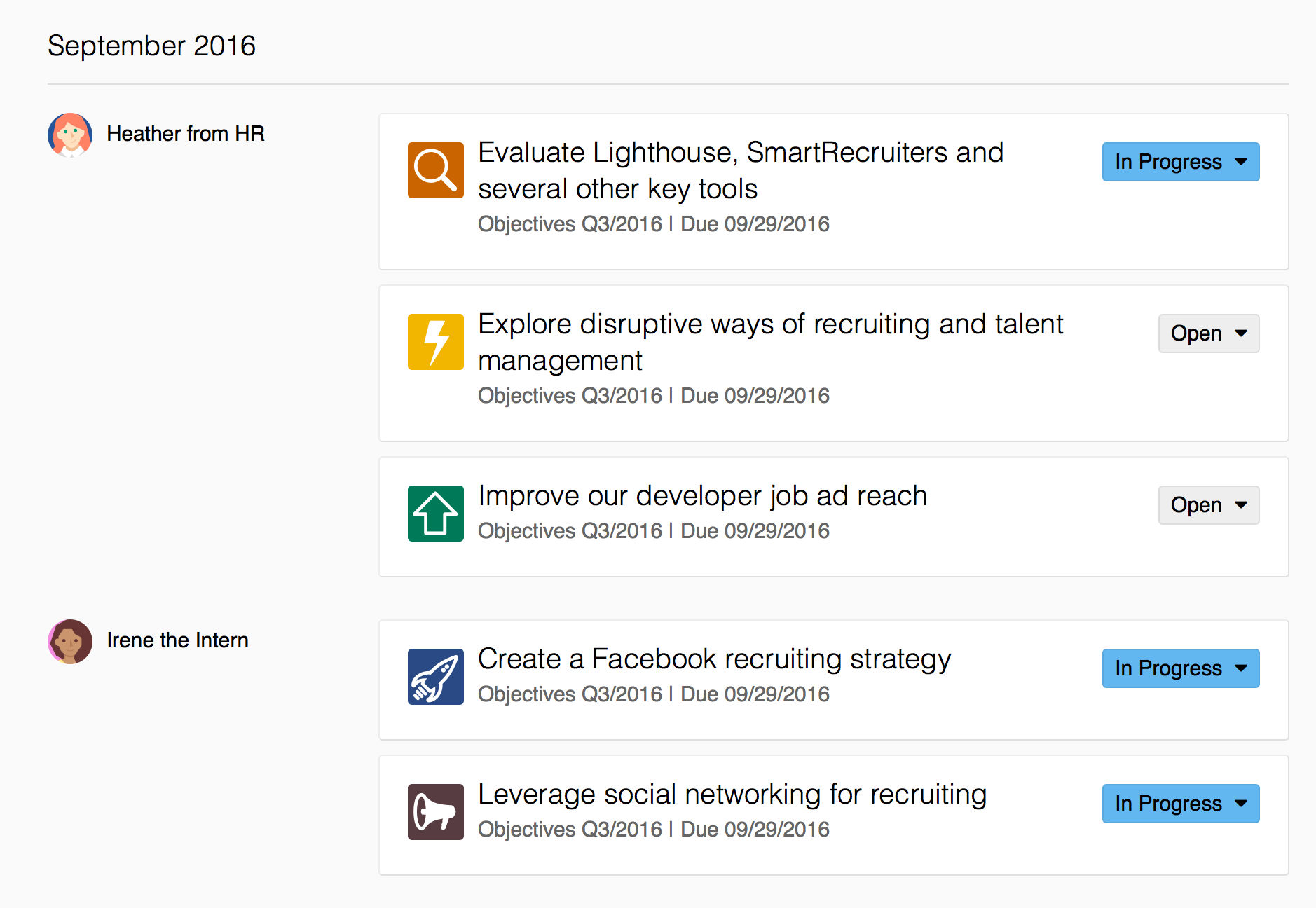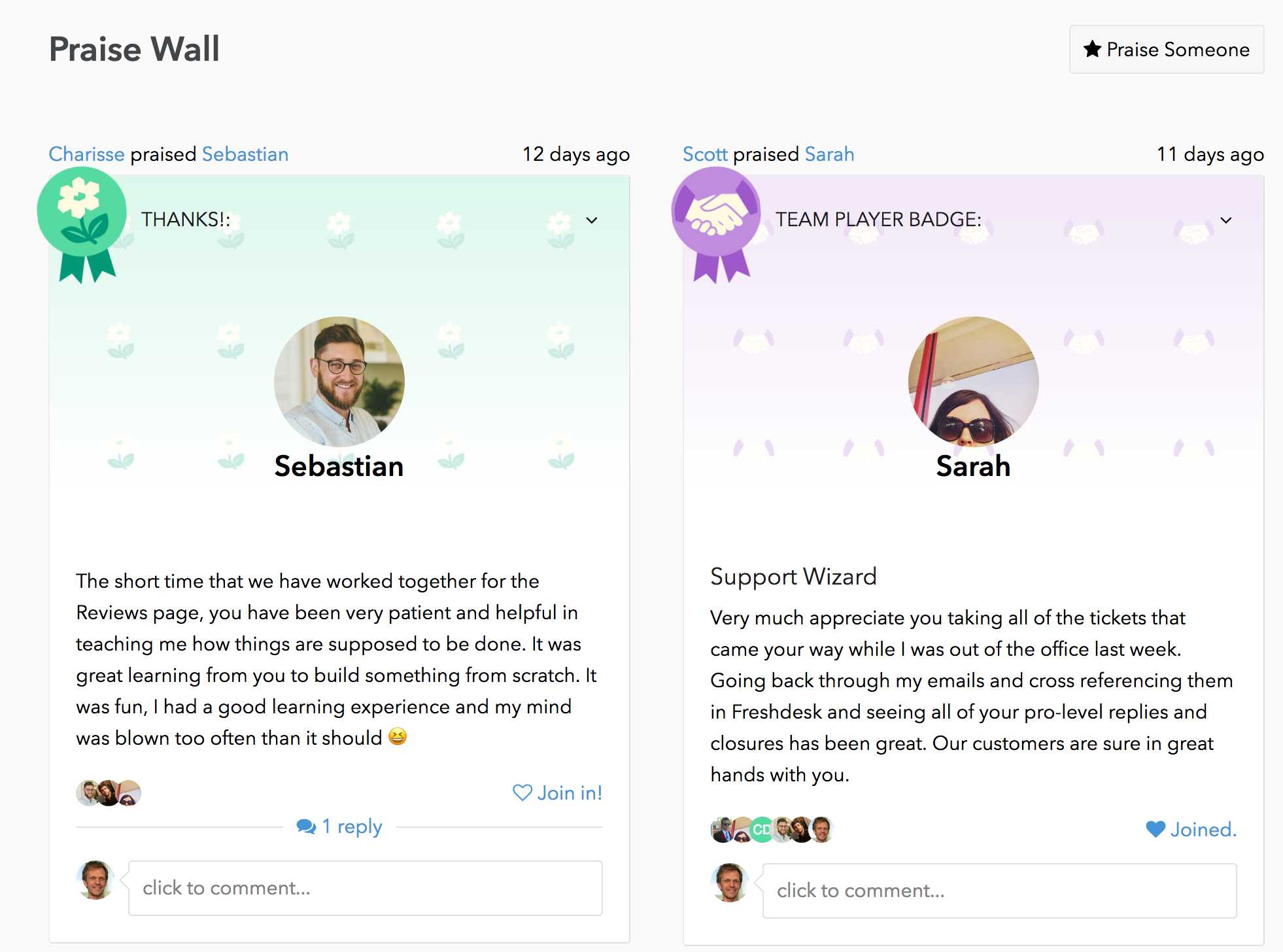Introducing a Performance Review System – The Gentle Way
If you want to redesign your performance review process but feel that selling the idea to your team might be difficult, you've come to the right place!
Instigating change is tricky, and introducing a new performance management system can backfire if not done properly. Read on for some suggestions on how to get started and avoid some common problems with performance management.
Getting started
We're all scared of change, especially if change gets imposed on us. Some people like to try out new approaches, but most don't. Even the most flexible employees can get really upset at the idea of having to move their desk 10 feet from room A to room B. The problem is you can't predict who gets scared of what change — but you can be certain that there's always a group of people who will be uncomfortable with even your best-laid plans.
This applies especially to products that may be seen as potentially having drawbacks, like a performance review tool. People who've never used one may have all sorts of fears about their manager abusing the system, or using it to make employees feel bad and not get a raise. That's why you need to be extra careful and gentle when introducing a new HR solution.
We've started to collect a few ideas about how to ease people into using Small Improvements, and some general advice for HR managers. This page is work in progress, and we'll be adding more hints over time. If you have some great tips of what worked best at your organization, do get in touch!
Pilot Phase

Let's assume you have evaluated Small Improvements with your HR team, and you like it. Your CEO has approved it, your CFO is happy about the low cost, and you'd love to start using it company-wide for your 300 staff right away. Well... don't!
Of course we want you to use Small Improvements company wide, because that means more revenue for us. But: We just don't want you to go overboard now!
Too many big projects have failed because some people got ahead of themselves, or underestimated the fear of change. So we strongly advise you to run a pilot phase before your company wide roll-out, this will highlight issues and concerns people have, and you can adapt your questionnaires, timeline-estimates and the like before you roll out full scale. By Pilot we mean that you use the product "for real", with actual performance reviews done or actual 360 feedback gathered. But only with a limited number of staff. These users should come from all levels of your organization, e.g. from intern to VP.
Ideally, you get two teams from different departments into the pilot phase. Try R&D vs Marketing -- you'll be surprised how different their responses and needs will be. Then ask these people for feedback, and take it into account, enhance your training material, and the full scale rollout will be a lot smoother.
We suggest that you aim for 10% of your actual staff. If you pick them carefully, and maybe even get some key people from other departments into the Pilot, you will have lots of people who can help you explain the system -- less work for you!
Explain, explain, explain!
Maybe you're a seasoned Human Resources manager, and have tons of experience with performance reviews, peer reviews, objective setting, incentive systems, etc. But your coworkers in other departments simply don't! Things that may seem totally obvious to you need to be explained in detail to everybody else. Your CFO can't transfer all her knowledge about financial forecasting to you in a 20 minute meeting, and you cannot explain all the advantages and intricacies of performance reviews in such a short time frame either. And while the CFO may actually be interested in your ideas, most of your staff probably aren't even keen (nor have much time) to learn about your work and experience. You will have to explain things over and over again. Get used to it.
"What's in it for me?"
It will take a lot of time and internal marketing to get any HR idea out there! In the case of Small Improvements, you will need to demonstrate to staff why they would benefit from peer feedback, or from webbased performance reviews, or both. Each company is different, so we can't provide you will blueprints here. Figure out what employees in your organization like and what they don't like about the existing (or non-existing) performance process, and explain in what ways Small Improvements helps. Some ideas to get you started:
- Learn what your strengths and weaknesses are. While continuous feedback is great, there are many things you'll only ever learn about in an official review. And the sooner you know, the better for your own sake. 2 small reviews per year are way more effective than one biggie per year.
- While 2 reviews per year is great, some 360 degree and/or continuous feedback throughout the year is even better: Getting even more timely feedback helps you react before the next official review is due
- Peer feedback may feel awkward at first, but it will be a lot more insightful than from a (distant) manager, and more balanced as well. Anonymous feedback sounds scary, but it really helps you get feedback that people otherwise would keep to themselves.
- Improved communication: Get to know what other departments are doing before it's "too late". By sharing your status and using the microblogging feedback, everyone's in the loop, preventing many problems before they become large issues.
- Learn from other people's goals and objectives. Share your own objectives so people can help you achieve them
- Praise others: Not just because it's nice to give, but also because it can inspire them to work better in general, benefitting the whole team
- Don't complain behind people's backs until a problem has become huge and insurmountable. Raise awareness for issues early, and prevent small problems from becoming big problems that ruin your work life balance
Don't use this as a blue print, explain to your staff in your own words why they will benefit from a more balanced system. It doesn't matter if you in HR benefit! To sell the idea make sure that regular employees will know how they benefit. Ultimately, everyone thinks about their own agenda first, so there has to be something in it for everyone.
Tip: Check out Jason Lauritsen's six tips on how to communicate a new performance management process.
Keep it simple and sweet

Pick few and simple questions: There's a huge temptation to make things complicated for the sake of completeness. Most companies start out with looong questionnaires when they set up their first performance management system, only to then shrink the questionnaires over time because they realise that it takes a lot of time to answer all questions, but doesn't add as much value as exptected! We strongly advise you to start out simple, and then grow complexity only when needed. You could start with just 2 questions in the performance review or 360 degree feedback: "What did the reviewee do well? And what could he/she improve on?" Of course you can provide some hints (e.g. "when answering, take into consideration our 5 company values or mission statement"). But we suggest you don't ask very specific questions ("what did the reviewee do well in terms of company value A?", ".... B?", ".....C?" and so on) because it pidgeonholes the answers and leaves less room for unexpected feedback, which might have been tons more relevant.
It's a lot better to get people writing (because it looks simple enough to answer 2 questions) than to intimidate them with a huge form that looks like a sh*tload of work. Ultimately, both ways may result in the same amount of data, but the first process just feels better, and the feedback is more honest. And it will be easier to start the process over in 6 months if people kind-of-enjoyed it before.
This applies to objectives as well. Do let people know that their objectives should be related to the company- or department goals -- but don't be too restrictive either, or you will end up with very specific objectives and miss out on innovative different ideas.
"Time-boxing": The law of diminishing returns also applies to the time investment. You will not get much better results out of a performance review by spending hours and hours. We suggest you spend no less than 30 minutes on your self-assessment but also no more than 2 hours on it. A manager should spend in between 60 minutes and 2 hours preparing and writing the performance review, another 30 to 45 minutes in the actual meeting, and then maybe another 30 minutes wrapping up. Significantly more time will probably make the review a little better, but not enough to justify the effort. And the longer it drags on, the more miserable people become.
By letting people know how much time you want them to spend at most, you will get better and more timely results.
It works really well to let departments (or large teams) pick a morning or an afternoon during which all self-assessments get written -- by every team member -- no excuses! People get no chance to procrastinate, meaning the burden seems smaller, and it's all over much faster than expected.
Get buy in from middle managers

Although it's very important to win the hearts and minds of everyone, the middle managers are really the core group of people you need to convince. They will take the brunt of the work. Not only do they have to write their own self-assessment and get reviewed by their boss (e.g. the department lead) but also do they have to run review sessions for their staff. So even if you keep the process short and sweet, managers in flat organizations will struggle and may have to deal with 10 or evn 15 reviews. This won't work if you failed to convince them! We provide you with nice status tracking and people-nudging tools, but if someone doesn't see the point, then their 15 reports' performance reviews won't be progressing no matter how often you nudge the manager.
In our opinion, the manager is the servant of the team, removing roadblocks and ensuring the machinery is well-oiled, so that the team can work at maximum productivity. A manager who sees himself like this will most likely understand the need for reviewing their team, and helping everyone get better. But managers who see themselves as "big leaders" may struggle, and hate the idea of doing work for their team (instead of vice versa). It will take some upfront explaining that the main reason for their big paycheck is that they occasionally have to do work they don't enjoy, like having tough discussions with their direct reports.
Naturally, it helps to get buy in from senior management first -- but don't expect that middle managers will mindlessly follow anything the VP tells them. Do spend time with your middle managers way before you introduce the (actually any!) system company-wide.
Train people face to face

While the Small Improvements application is pretty straight forward, the last thing any employee enjoys is a "letter from headquarters" telling them to do this and that. While this may work in very hierarchical and traditional workforces, it's not so effective in collaborative or creative environments, and let's not get started about Gen Y here! 🙂 It's going to save you plenty of hassle if you run training sessions face to face, showing your respect to everyone, and being able to get feedback and take it into account.
As an example, at Atlassian, when introducing their first official performance process, HR organised meetings for the entire company to explain the concept — not at a single all-hands meeting, but at 10 separate meetings with 20 employees each! HR managers also emphasised that they'd arrange for individual 1:1 meetings for everyone who had further questions or concerns they didn't want to address in a group meeting.
Running ten separate meetings at 30-45 minutes each put a lot of stress on the HR managers, but it showed each employee how serious HR were taking everyone's concerns. And of course it helped HR to get very valid feedback which was incorporated into the process even before it started. You don't get that kind of feedback at an all-hands meeting where key people are too shy to speak up.
Even if you already have a performance review process and merely want to change it, training sessions (with small groups!) will help. You should also consider setting up dedicated sessions with all the middle managers, who will be the backbone of the performance review process! No need to talk to each team lead individually, but maybe you can have one meeting with the 5 development leads, one with the 3 marketing leads, and one with the 6 support leads. You get the picture.
Blog about it internally. Explain it on the intranet.
Assuming you have an intranet, get out there and write about it! (If you don't, at least send a friendly email.) Make sure that the feedback-feature is on so people can comment on your post and vent. Don't get surprised or offended by criticism, but on the contrary, be grateful that someone actually read your post and has some feedback. Take feedback seriously and answer it right away. Try to win their hearts.
Focus. Make clear what parts of SI you'll be using, disable the others
Small Improvements has 4 core modules: Reviews, 360s, Continuous Feedback, and Goals and Objectives. During a pilot phase you may not want people to use every feature! Maybe you want to start with performance reviews, and not do 360 degree feedback. You can either disable some features entirely, or (if some staff need access to all modules) make clear to your staff what features to use. This reduces the risk of overwhelming staff — after all, Small Improvements does have plenty of powerful features, and why bother explaining them all if you only intend to use half of them.
In fact, we can help you as well, for instance by finetuning the application beyond the simple disabling of features: We could hide additional menu items or buttons you don't want people to use. Just let us know!
Seed the system for Objectives usage
Assuming you want to use Small Improvements to let everyone create, track and share their objectives, you will want to lead by example as well. Start out by defining and sharing some of your objectives. Then get some of the key managers involved, and have them share their objectives with the rest of the company (at least those parts that make sense for public consumption). The goals will show up in people's daily status mails, encouraging them to follow the link to learn more. Once they're in the system, other news may catch their attention, or they may start to contribute as well. Again, try to get buy in from key people who are well-respected or well-liked.

Seed the system for Continuous Feedback
If you want to start using Small Improvements for giving feedback and for sharing praise, your best bet is to get a few stakeholders on board and seed the system with praise!
You can still later on encourage people to request feedback on their own, or to give constructive feedback in private. First off, it matters that employees can see positive examples by people they respect, and while this includes HR, each team will also love seeing their managers contributing.
This will attract people's attention, they will get used to catching up by reading their daily status mails, and at some point they will want to contribute.
You might chat with some key managers or "people people" and ensure that the first 3 weeks, people already know whom to praise for what. This way you get to critical mass, and everyone else will slowly follow suit.
Get together with others who can see the value of Small Improvements, and discuss who will post what information. Make sure that there are a few things in the pipeline, and then there's a huge chance that it will catch on and you can stop seeding, and just post information you intended to post anyway.

Be creative. And share your ideas!
This document is really just a first step. It's really up to your company or your HR department to work with your coworkers and come up with a process that works for you. If you've never done performance management before, getting some outside is always a good idea.
Do you have further ideas, and would you like to share them? You're more than welcome to send us an email and let us know how you introduced performance reviews or 360s into your organization, and what pitfalls to be aware of. We're happy to share your insight, or even write a use case together with you and promote it. Get in touch!